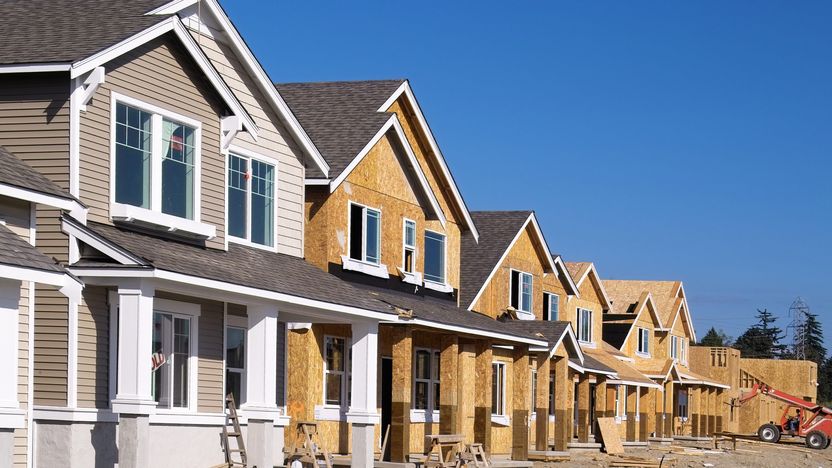By Clare Trapasso

(Getty Images)
First-time homebuyers in the market today have a litany of woes. Home prices are at record highs. Saving for a down payment is tougher than ever due to soaring inflation. And now, mortgage interest rates are much higher than they were a year ago—making monthly housing payments even more expensive.
Many first-time buyers have been forced to slash their expectations as they can no longer afford their dream homes or to live in their dream neighborhoods. Others have been priced out of homeownership or are considering holding off on making such a large purchase.
But before you throw up your hands in defeat, take a deep breath. The homebuying situation might not be as bleak as it seems.
Mortgage rates have been coming down—a little—over the past few weeks. And they aren’t set in stone. They typically move a bit up or down multiple times a day. They’re also negotiable. Though you may see a certain rate advertised or your lender quotes a higher-than-desired rate, it doesn’t mean you can’t get it down. There are a variety of things potential borrowers can do to bring down their rates, including boosting their credit profile, shopping around, and paying a little extra at closing.
It just takes some work.
For context, mortgage rates averaged about 4.99% in the week ending Aug. 4 for 30-year fixed-rate loans, according to Freddie Mac. While historically that’s not too bad—considering rates peaked at about 18.44% in 1981—it’s a whole lot higher than last year, when they averaged just 2.8%. (Mortgage rates don’t change after a borrower purchases a home with a fixed-rate loan.)
Many folks might not think an increase of only 2.5 percentage points is that impactful, but they would be wrong. That kind of increase adds more than $500 a month to a typical mortgage payment. That’s a lot of money for any buyer, particularly one just starting out. Over 30 years, that costs buyers an additional $187,000 or more. (This assumes buyers put 20% down on a median-priced home of $450,000 and doesn’t include property taxes or insurance costs.)
That’s why it really pays to score a lower rate. Here are some tips for buyers on how to bring down mortgage rates.
1. Raise your credit score, pay off debt

Those trying to get a lower mortgage rate need to work on improving their credit scores and paying off old bills.(Getty Images)
One of the best ways to score a lower mortgage rate is to convince lenders that you’re a highly qualified borrower who won’t have any trouble making your mortgage payments in full every month. The riskier a lender believes a potential borrower is, the more it charges in fees and higher mortgage rates. They’re essentially compensating themselves for the higher risk they’re taking on.
Lenders look at a variety of things, including a potential borrower’s credit score and amount of debt. Those with higher credit scores generally have a longer credit history of making on-time payments. And those with less debt are considered by lenders to have more money available to put toward their mortgage payments.
Those trying to get a lower mortgage rate need to work on improving their credit scores and paying off old bills. Borrowers should request their credit histories from one of the big credit bureaus, which are Equifax, Experian, and TransUnion, and then comb through them.
Are there any mistakes in their credit reports that they can have addressed? Is there anything they can pay off pronto? Sometimes (but definitely not always) credit card and other companies will remove late payment reports if the borrower calls up and asks nicely. Every little bit helps.
2. Make a larger down payment
Lenders often consider homebuyers who put down 20%—or more—as safer bets. So loan officers may be willing to come down a little on rates if buyers have the extra cash to put down.
That may not be feasible for many first-time homebuyers scrambling to cobble together a down payment while contending with higher rents and high inflation. However, those who have a little extra saved up may want to check in with their lenders to see if it will make a difference.
3. Buy mortgage points to lower your rate
Borrowers with cash to spare should also look into buying down their mortgage rates. This is when the borrower pays the lender a fee to buy points, which drops the rate just a little.
Points are typically sold in 0.25% increments and cost about 1% of the full mortgage amount (although that can vary). So borrowers could pay $4,000 per point on a $400,000 mortgage to bring down their rates by 0.25%. Sometimes they can even purchase a fraction of a point.
While it costs more upfront, borrowers who can afford the points and plan to stay in their homes for a while should run their numbers to see if it will pay off in the long term. Payment for those points is usually due at the borrower’s closing.
4. Consider new construction

It doesn’t hurt to see what your local builders are offering.(Getty Images)
Some builders are also willing to buy down the mortgage rates of those shopping for newly constructed homes. During the COVID-19 pandemic, new construction was a hot commodity. Builders had potential buyers on seemingly infinite waiting lists. All of that is now long gone as their reserves of buyers dried up.
Now builders are much more willing to cut a deal—and that includes buying down the mortgage rates of buyers and offering rate locks. In some cases, buyers can get into new construction with a rate in the high 4% range, say real estate consultants.
It doesn’t hurt to see what your local builders are offering. If they’re not offering to buy down rates, you lose nothing by asking if that’s something they would consider.
5. Compare lenders—and make them compete for your business
Now that mortgage rates have risen, lenders are left with a lot fewer customers than they had just a year ago. Prospective borrowers can use that to their advantage to get the best possible deal—especially if they shop around.
When my now-spouse and I had our first offer accepted last year, we contacted our bank, where we had been pre-approved for a mortgage. The offer the loan officer came back with wasn’t great. The lender wanted us to pay thousands of dollars in points to bring it down a fraction of a percentage point. We began looking elsewhere.
I found an online brokerage that was offering lower rates without the points. So I applied. When the brokerage came back with a higher rate than what it advertised online, I took a screenshot of the ad and submitted it to the company, which agreed to honor it.
Then we basically created a bidding war for our business. I took the online brokerage’s offer to our bank as well as our credit union. Both agreed to match it. We chose our bank because it agreed to a fast close. It even lowered its other mortgage fees as well.
The lesson: Don’t be afraid to play lenders against one another to get the best possible deal for yourself.
6. Shop around for the best loan for you

Compare the pros and cons of different kinds of loans.(Getty Images)
Borrowers should also compare the pros and cons of different kinds of loans. Some government loans and government-backed loans offer lower mortgage rates than conventional ones.
U.S. Department of Veterans Affairs mortgages, which are for veterans and members of the U.S. armed forces, often provide lower rates than competitors. U.S. Department of Agriculture and Federal Housing Administration loans may also give borrowers a bit of a break depending on the borrower’s financials.
But borrowers be warned: Many government and government-backed loans require borrowers without large down payments to take out costly private mortgage insurance. That may eat into or erase any potential savings that borrowers receive by having a lower rate.
Source: https://www.realtor.com/advice/buy/on-the-house-how-to-bring-down-your-mortgage-rate/
